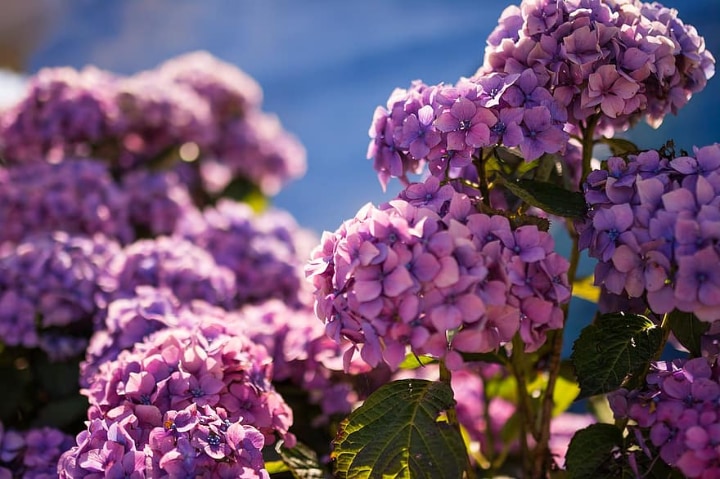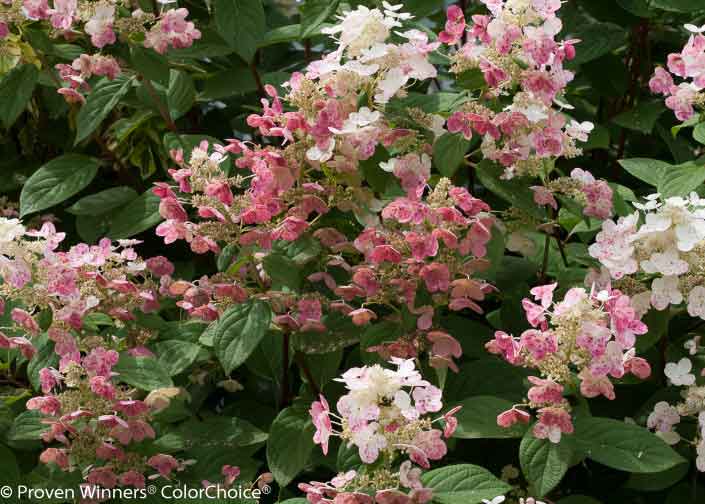Understanding Hydrangea Sun Tolerance
Hydrangeas are a popular choice for gardeners, but their sun tolerance can vary greatly depending on the type of hydrangea. While some hydrangeas can thrive in full sun, others may require partial shade to prevent scorching. Bigleaf hydrangeas, for example, prefer partial shade, especially in warmer climates, as they can be sensitive to intense sunlight. On the other hand, Panicle and Smooth hydrangeas are more tolerant of full sun and can thrive in conditions with direct sunlight for 6 hours or more.
When considering whether to plant hydrangeas in full sun, it’s essential to understand the specific needs of the variety you’re growing. Some hydrangeas, like ‘Limelight’ and ‘Vanilla Strawberry’, are bred to be more sun-tolerant and can perform well in full sun, while others may require more shade. By understanding the sun tolerance of your hydrangea variety, you can provide the best conditions for optimal growth and blooming.
In general, hydrangeas prefer well-draining soil and consistent moisture, regardless of their sun tolerance. However, hydrangeas in full sun may require more frequent watering to prevent drought stress. By providing the right conditions and care, you can enjoy beautiful blooms and lush foliage from your hydrangeas, even in full sun.
So, can you plant hydrangeas in full sun? The answer is yes, but it’s crucial to choose a variety that’s tolerant of full sun and provide the right care and conditions. With the right selection and care, hydrangeas can thrive in full sun and add beauty and elegance to your garden.
How to Choose the Right Hydrangea for Full Sun
When it comes to growing hydrangeas in full sun, selecting the right variety is crucial. Not all hydrangeas are created equal, and some are better suited for full sun than others. Bigleaf hydrangeas, for example, are not the best choice for full sun, as they can be sensitive to intense sunlight. However, Panicle and Smooth hydrangeas are excellent options for full sun, as they are more tolerant of heat and drought.
Panicle hydrangeas, such as ‘Limelight’ and ‘Vanilla Strawberry’, are known for their large, showy flowers and ability to thrive in full sun. They can tolerate temperatures up to 90°F (32°C) and require minimal shade. Smooth hydrangeas, like ‘Annabelle’ and ‘Invincibelle Spirit’, are also great options for full sun, as they are more compact and produce smaller, but still beautiful, flowers.
When choosing a hydrangea variety for full sun, consider the following factors:
- Heat tolerance: Look for varieties that can tolerate high temperatures and intense sunlight.
- Drought tolerance: Choose varieties that are resistant to drought and can thrive with minimal watering.
- Soil requirements: Select varieties that prefer well-draining soil and can thrive in a variety of soil types.
- Flower size and color: Consider the size and color of the flowers, as well as the blooming period, to ensure you get the desired effect.
By considering these factors and choosing the right hydrangea variety, you can enjoy beautiful blooms and lush foliage in full sun. Remember, can you plant hydrangeas in full sun? Yes, you can, with the right selection and care.
Preparing the Soil for Full Sun Hydrangeas
Soil preparation is a crucial step in growing hydrangeas in full sun. Hydrangeas prefer well-draining soil that is rich in organic matter, and the right pH level is essential for optimal growth. Before planting, it’s essential to test the soil to determine its pH level and nutrient content.
The ideal pH range for hydrangeas is between 6.0 and 7.0, although some varieties can tolerate a slightly wider range. If the soil is too acidic or too alkaline, it can affect the plant’s ability to absorb nutrients, leading to poor growth and flowering.
To test the soil, you can purchase a soil testing kit or send a sample to a laboratory for analysis. Based on the test results, you can amend the soil to achieve the optimal pH level. Adding organic matter such as compost or well-rotted manure can help improve the soil’s structure and fertility.
In addition to pH, hydrangeas also require adequate nutrients to thrive. A balanced fertilizer with a ratio of 10-10-10 (nitrogen-phosphorus-potassium) can provide the necessary nutrients for healthy growth. However, it’s essential to avoid over-fertilizing, as this can damage the plant and lead to poor flowering.
When preparing the soil for full sun hydrangeas, it’s also essential to consider the soil’s water-holding capacity. Hydrangeas prefer moist soil, but they can be susceptible to root rot if the soil is too wet. Adding organic matter can help improve the soil’s water-holding capacity, reducing the need for frequent watering.
By preparing the soil correctly, you can create an ideal environment for your hydrangeas to thrive in full sun. Remember, can you plant hydrangeas in full sun? Yes, you can, with the right soil preparation and care.
Planting Hydrangeas in Full Sun: Tips and Tricks
Planting hydrangeas in full sun requires careful consideration of the timing, spacing, and watering. To ensure successful growth, follow these tips and tricks:
Best Time to Plant: The best time to plant hydrangeas in full sun is in the early morning or late afternoon when the sun is not too intense. This allows the plant to establish itself before being exposed to direct sunlight.
Spacing: Plant hydrangeas at least 3-4 feet apart to allow for good air circulation and prevent overcrowding. This also helps to prevent the spread of disease and pests.
Watering: Hydrangeas in full sun require consistent moisture, especially during the first year after planting. Water them deeply once or twice a week, depending on weather conditions. Avoid getting water on the leaves or flowers to prevent fungal diseases.
Mulching: Mulching around the base of the hydrangea helps to retain moisture, suppress weeds, and regulate soil temperature. Use a 2-3 inch layer of organic mulch such as wood chips or bark.
Fertilizing: Feed hydrangeas in full sun with a balanced fertilizer in the spring and again in the summer. Avoid over-fertilizing, as this can damage the plant and lead to poor flowering.
Soil Temperature: Hydrangeas prefer soil temperatures between 60-70°F (15-21°C). If the soil temperature is too high, it can cause stress to the plant and lead to poor growth.
By following these tips and tricks, you can successfully plant hydrangeas in full sun and enjoy their beautiful blooms and lush foliage. Remember, can you plant hydrangeas in full sun? Yes, you can, with the right care and attention.
Common Challenges and Solutions for Hydrangeas in Full Sun
While hydrangeas can thrive in full sun, they can also face some common challenges. Here are some of the most common issues and their solutions:
Leaf Scorch: Leaf scorch is a common problem for hydrangeas in full sun, especially during hot summer months. To prevent leaf scorch, make sure to provide enough water and mulch around the base of the plant. You can also use a shade cloth to filter the intense sunlight.
Wilting: Wilting is another common issue for hydrangeas in full sun. To prevent wilting, make sure to water the plant regularly and provide enough moisture. You can also use a drip irrigation system to deliver water directly to the roots.
Pest Problems: Pests like aphids, whiteflies, and spider mites can be a problem for hydrangeas in full sun. To control pests, use neem oil or insecticidal soap. You can also introduce beneficial insects like ladybugs or lacewings to control pest populations.
Root Rot: Root rot is a common problem for hydrangeas in full sun, especially if the soil is too wet. To prevent root rot, make sure to provide good drainage and avoid overwatering. You can also use a fungicide to control root rot.
By being aware of these common challenges and taking steps to prevent them, you can enjoy healthy and thriving hydrangeas in full sun. Remember, can you plant hydrangeas in full sun? Yes, you can, with the right care and attention.
Hydrangea Care in Full Sun: Ongoing Maintenance
Once you’ve planted your hydrangeas in full sun, it’s essential to provide ongoing maintenance to ensure they continue to thrive. Here are some tips to help you care for your hydrangeas:
Pruning: Prune your hydrangeas in late winter or early spring to maintain their shape and promote new growth. Remove any dead or damaged branches, and cut back the stems to about 12-18 inches from the ground.
Deadheading: Deadheading is the process of removing spent flowers from your hydrangeas. This helps to encourage new blooms and maintain the plant’s appearance. Simply snip off the faded flowers at the base of the stem.
Fertilizing: Fertilize your hydrangeas in the spring with a balanced fertilizer. This will provide them with the necessary nutrients to promote healthy growth and blooming.
Monitoring: Keep an eye on your hydrangeas’ performance and adjust their care accordingly. If you notice any signs of stress or disease, take action promptly to prevent the problem from spreading.
Weather Conditions: Be aware of weather conditions that may affect your hydrangeas, such as extreme heat or cold, drought, or excessive rainfall. Take steps to protect your plants from these conditions, such as providing shade or supplemental watering.
By following these tips, you can provide your hydrangeas with the care they need to thrive in full sun. Remember, can you plant hydrangeas in full sun? Yes, you can, with the right care and attention.
Popular Hydrangea Varieties for Full Sun
There are many beautiful hydrangea varieties that thrive in full sun. Here are a few popular options:
‘Limelight’ Hydrangea: This variety is known for its large, bright green leaves and its ability to produce white flowers in the summer. It can grow up to 6 feet tall and 4 feet wide, making it a great choice for hedges or borders.
‘Vanilla Strawberry’ Hydrangea: This variety is a type of panicle hydrangea that produces white flowers that turn pink in the fall. It can grow up to 6 feet tall and 4 feet wide, and is a great choice for adding a pop of color to your garden.
‘Tardiva’ Hydrangea: This variety is a type of panicle hydrangea that produces white flowers in the late summer. It can grow up to 6 feet tall and 4 feet wide, and is a great choice for adding a touch of elegance to your garden.
These are just a few examples of the many beautiful hydrangea varieties that can thrive in full sun. By choosing the right variety for your garden, you can enjoy the beauty of hydrangeas all season long. Remember, can you plant hydrangeas in full sun? Yes, you can, with the right variety and care.
Conclusion: Growing Hydrangeas in Full Sun with Confidence
With the right knowledge and care, you can successfully grow hydrangeas in full sun. By choosing the right variety, preparing the soil, and providing ongoing maintenance, you can enjoy the beauty of hydrangeas all season long.
Remember, can you plant hydrangeas in full sun? Yes, you can, with the right variety and care. By following the tips and guidelines outlined in this article, you can grow healthy and thriving hydrangeas in full sun.
Final Tips and Reminders:
- Choose a hydrangea variety that is tolerant of full sun.
- Prepare the soil with the right pH and nutrient levels.
- Plant hydrangeas in the morning or late afternoon to avoid intense sunlight.
- Water hydrangeas regularly, but avoid overwatering.
- Mulch and fertilize hydrangeas regularly to promote healthy growth.
- Monitor and adjust care based on weather conditions and plant performance.
By following these tips and guidelines, you can grow beautiful and thriving hydrangeas in full sun. Happy gardening!






